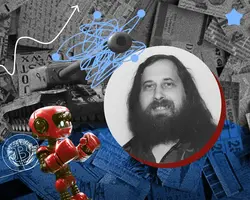news
Silicon Tanks: Richard Stallman, father of copyleft
In the late 1970s the programming community faced an unexpected threat as corporations began to monetise software that had previously been shared for free. Many talented engineers eventually capitulated in the uneven contest between enthusiasts and tech giants—but not hacker Richard Stallman.
How he managed to spark a revolution in software freedom is the subject of a new instalment in the Silicon Tanks series, in which ForkLog revisits the most influential visionaries in IT.
Hackers, corporations and a faulty printer
Richard Matthew Stallman, who gained early notoriety in the hacker community as RMS, was born on March 16, 1953, in New York. He graduated from Harvard University in 1974 and entered graduate school at the Massachusetts Institute of Technology (MIT). He soon left the programme, but kept his job as a programmer at MIT’s Laboratory for Computer Science and Artificial Intelligence, where he had worked since 1971.
At the time Stallman joined a community whose members actively shared experience and software needed to create new programs. The free exchange of information became more difficult with the advent of commercial software.
In the early 1980s Digital Equipment Corporation stopped supplying hardware for the PDP-10 machines used by the lab’s team. And in 1981 almost all of Stallman’s colleagues left for Symbolics.
Computers of the day had their own operating systems, but none was “free”. At the new companies, employees were required to sign non-disclosure agreements before receiving executables. Participation in the hacker community was forbidden.

